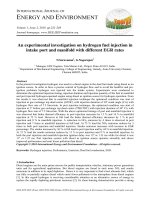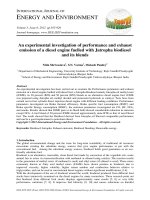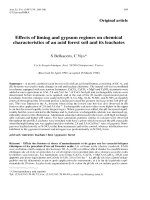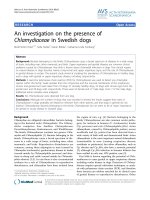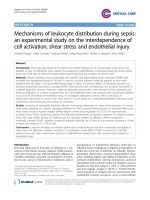An experimental investigation on surface characteristics of tool steel using powder mixed micro EDM
Bạn đang xem bản rút gọn của tài liệu. Xem và tải ngay bản đầy đủ của tài liệu tại đây (8.56 MB, 133 trang )
AN EXPERIMENTAL INVESTIGATION ON SURFACE
CHARACTERISTICS OF TOOL STEEL MACHINED BY
POWDER MIXED MICRO-EDM
MOHAMMED MUNTAKIM ANWAR
NATIONAL UNIVERSITY OF SINGAPORE
2008
AN EXPERIMENTAL INVESTIGATION ON SURFACE
CHARECTERISTICS OF TOOL STEEL MACHINED BY
POWDER MIXED MICRO-EDM
MOHAMMED MUNTAKIM ANWAR
(B.Sc. in Mechanical Engineering, BUET)
A THESIS SUBMITTED
FOR THE DEGREE OF MASTER OF ENGINEERING
DEPARTMENT OF MECHANICAL ENGINEERING
NATIONAL UNIVERSITY OF SINGAPORE
2008
Acknowledgements
Acknowledgements
I would like to express my deepest and heartfelt gratitude and appreciation to my
Supervisors, Professor Wong Yoke San and Professor Mustafizur Rahman for their
valuable guidance, continuous support and encouragement throughout the tenure. They
have provided valuable suggestions from the development of my thesis concept to the
fulfillment of my research work. Without their continuous supervision it would have
been impossible to manage the research within this short period.
I would like to take this opportunity to thank National University of Singapore (NUS)
for providing me with research scholarship and sufficient funds for purchasing
different materials to carry out my research work. The rich state of the art facilities and
support of Advanced Manufacturing Lab (AML) and Micro Fabrication Lab provided
the opportunity to carry out experiments and their analysis smoothly.
.
I also would like to take this opportunity to thank the following staff for their sincere
help, guidance and advice without which this project would not be successfully
completed: Mr. Tan Choon Huat, Mr. Lim Soon Cheong and Mr Wong Chian Long
from Advanced Manufacturing Lab (AML) and Mr Lee Chiang Soon from Workshop
2. Special thanks go to Mr Abu Bakar Md Ali Asad, an M.Eng candidate of NUS, and
Atikur Rahman from Mikro tools, a NUS spin off company, for their help with the
machine set-up and for their guidance and technical assistance provided during
different period of my research. I would also like to thank Mr. Muhammad Pervej
Jahan, a PhD candidate of NUS, for his valuable advice and encouragement during my
experimental work.
I
Acknowledgements
I would like to offer my appreciation for the support and encouragement during
various stages of this research work to my labmates and friends. My appreciation goes
to Mohammad Ahsan Habib, Chandra Nath, Woon Keng Soon, Sadiq Mohammad
Alam, Mohammad Sazedur Rahman, Masheed Ahmad, Angshuman Ghosh, Md. Saiful
Karim, Saira Sanjida, Md. Ershadul Alam, Mohammad Iftekhar Hossain, Abdullah Al
Mamun and many more. Special thanks to all of them for being so supportive for the
past two years.
Last but not the least, my heartfelt gratitude goes to my mother, Ms Shirin Akhter, for
her loving encouragement and best wishes throughout the whole period and my father,
Mr. Manjour Murshed Anwar, for his mental support and encouragement. I would also
like to convey my sincere gratitude to my loving sister, Ms Nawrin Anwar for her
inspiration and my aunty, Ms Rumaisa Samad, for always being there.
II
Table of contents
Table of Contents
ACKNOWLEDGEMENTS
TABLE OF CONTENTS
SUMMARY
I
III
VII
LIST OF TABLES
X
LIST OF FIGURES
XI
CHAPTER 1
INTRODUCTION
1
1.1 Motivation
1
1.2 Objectives of the research
3
1.3 Organization of the thesis
4
CHAPTER 2
LITERATURE REVIEW
6
2.1 Introduction
6
2.2 Historical Background of EDM
7
2.3 Principles of EDM
8
2.4 Micro-EDM and its type
9
2.5 Micro-EDM compared to other Micro-machining processes
10
2.5.1 Advantages of micro-EDM over other micromachining processes
10
2.5.2 Compatibility of micro-EDM with other micromachining processes
10
III
Table of contents
2.6 Key system components of Micro-EDM
11
2.7 Types of pulse generator
12
2.8 Surface characteristics after EDM
14
2.9 Characteristics of powder EDM process
17
2.9.1 Mechanism of powder EDM process
17
2.9.2 Influence of powder EDM in surface roughness
20
2.9.3 Influence of powder EDM in surface modification
22
2.10 Conclusion
23
CHAPTER 3
EXPERIMENTAL DETAILS
26
3.1 Introduction
26
3.2 Experimental setup
26
3.2.1 Multi-purpose miniature machine
26
3.2.2 Workpiece material
29
3.2.3 Tool material
30
3.2.4 Dielectric
30
3.2.5 Powder material
31
3.2.6 Magnetic filter
32
3.3 Experimental procedure
33
3.3.1 Electrode dressing
33
3.3.2 Machining parameter
36
3.3.3 Machining details
36
IV
Table of contents
3.4 Measurement apparatus
3.4.1 Atomic force microscope (AFM)
37
37
3.4.2 Scanning electron microscope (SEM) and Energy
Dispersive X-ray (EDX) machine
38
3.4.3 Keyence VHX digital microscope
38
CHAPTER 4
RESULTS AND DISCUSSIONS
40
4.1 Introduction
40
4.2 Micro-EDM of SKH-51 tool steel
41
4.2.1 Analysis for die sinking micro-EDM
41
4.2.1.1 Surface topography
41
4.2.1.2 Surface roughness
44
4.2.1.3 Peak to valley height
47
4.2.2 Analysis for scanning micro-EDM
48
4.2.2.1 Surface topography
48
4.2.2.2 Surface roughness
53
4.2.2.3 Peak to valley height
56
4.3 Powder mixed micro-EDM of SKH-51 tool steel
4.3.1 Analysis for powder mixed die sinking micro-EDM
58
58
4.3.1.1 Surface topography
58
4.3.1.2 Surface roughness
61
4.3.1.3 Peak to valley height
64
V
Table of contents
4.3.2 Analysis for powder mixed scanning micro-EDM
67
4.3.2.1 Surface topography
67
4.3.2.2 Surface roughness
70
4.3.2.3 Peak to valley height
72
CHAPTER 5
CONCLUSION AND RECOMMENDATIONS
5.1 Conclusion
75
5.2 Recommendations
79
BIBLIOGRAPHY
81
LIST OF PUBLICATIONS
89
Appendix A
A-1
Appendix B
B-1
Appendix C
C-1
VI
Summary
Summary
Electrical Discharge Machining (EDM) is a non traditional machining process that has
become a well established machining option in manufacturing industries throughout
the world and has replaced drilling, milling, grinding and other traditional machining
operations. EDM is capable of machining geometrically complex or hard material
components that are precise and difficult to machine. In recent years numerous
developments in EDM focused in the fabrication of micro tools, micro components and
parts with micro features. Due to negligible forces and good repeatability of the
process, micro-EDM has become the best means for achieving high aspect ratio micro
features.
For the fabrication of complex 3-D molds using tough die materials, micro-EDM is
one of the successfully applied machining processes. Since the surface finish of the
micro mold cavity affects the surface quality of the finished products, it is necessary to
perform investigation about how to improve surface roughness using micro-EDM.
Moreover fabrication of parts smaller than several micrometers requires pulse duration
of several dozen of nanoseconds. Since RC type pulse generator can generate such
small energy by simply minimizing the capacitance, it is necessary to investigate the
effect of such pulse generators in fine finish micro-EDM.
In view of this ongoing challenge to improve surface finish by micro-EDM, a series of
experiments were conducted using tungsten electrode of 500µm diameter as a tool and
SKH-51 tool steel as workpiece to machine blind holes of 5 µm depth on the
workpiece using RC type pulse generator. The aim is to find the correct combinations
VII
Summary
of parameters that result in better surface characteristics. The effect of voltage and
capacitance on surface topography and surface roughness were investigated.
Since most of the study on surface characteristics of EDM has been conducted using
die sinking method, it is important to adopt scanning micro-EDM to evaluate if there is
any change in surface characteristics. In this point of view experiments are conducted
using 500 µm tungsten electrodes to machine 1 mm slot at a depth of 5 µm on SKH-51
tool steel. The combination of voltage and capacitance settings for best surface finish
is evaluated. The results were compared with die-sinking micro-EDM.
With the continuous process improvement in EDM, the demand for high machining
precision with low surface roughness at relatively high machining rates arise in die,
mold and tool manufacturing industries. To fulfill this requirement a relatively new
advancement in the direction of process capabilities is the addition of powder in the
dielectric fluid of EDM. The results show that powder mixed EDM (PMEDM) can
distinctly improve the surface finish and surface quality. Following the results on
studies conducted on the use of PMEDM, an extension of this technique to microEDM is essential. In this aspect graphite powder with average particle size of 55 nm
was mixed with EDM oil at a concentration of 2 g/l and die sinking micro-EDM were
conducted to find the correct combination of voltage capacitance setting that results in
improved surface quality. The results were compared with die-sinking micro-EDM
conducted without powder.
VIII
Summary
In the final part of the study a combination of powder added dielectric and tool
movement were applied to study the effect of powder mixed scanning micro-EDM on
the surface roughness. The results were compared with scanning micro-EDM without
powder additives.
Therefore in this study effort has been made to employ the micro-EDM process in
surface study considering different types of dielectric using both die sinking and
scanning micro-EDM. The results show that powder added dielectric and scanning
method
together
generates
the
best
surface
finish
in
micro-EDM.
Few
recommendations for further improvements are also put forward.
IX
List of tables
List of Tables
Table 2.1 Overview of the micro-EDM varieties
10
Table 2.2 Compatibility of machining technologies with different materials
11
Table 3.1 Chemical Composition of SKH-51 tool steel
29
Table 3.2 Heat treatment and Hardness of SKH-51 tool steel
29
Table 3.3 Properties of Tungsten Tool Electrode
30
Table 3.4 Properties of EDM 3 Dielectric fluid
31
Table 3.5 Properties of graphite powder
32
Table 3.6 Specifications of magnetic filter
33
Table 3.7 Parameters used in machining
36
X
List of figures
List of figures
Figure 2.1 Different types of pulse generators (a) RC type and (b) Transistor type
12
Figure 2.2 Schematic representation of layer-by-layer scanning µEDM
24
Figure 3.1 Block diagram of Multi-Purpose Miniature
Machine Tool used for micro-EDM
27
Figure 3.2 Multi-purpose Miniature Machine Tool with micro-EDM attachment
27
Figure 3.3 Detailed view of the setup with micro-EDM attachment
28
Figure 3.4 Magnetic filter used in powder mixed micro-EDM
32
Figure 3.5 Optical image of electrode surface after cutting from bulk
33
Figure 3.6 Optical image of the electrode after first step of dressing
34
Figure 3.7 Electrode dressing methods (a) first step with plate micro-EDM,
(b) second step with scanning micro-EDM
35
Figure 3.8 SEM images of electrode after dressing (a) electrode surface after
first step dressing, (b) electrode surface after second step dressing
35
Figure 3.9 Atomic Force Microscope
37
Figure 3.10 Scanning Electron Microscope (SEM) also with
Energy Dispersive X-ray (EDX) device
38
Figure 3.11 Keyence VHX Digital Microscope
39
Figure 4.1 Optical images of surface after die sinking micro-EDM
at 120 volt setting using (a) 10 pf, (b) 100 pf
42
Figure 4.2 SEM images of surface after die sinking micro-EDM
at 120 volt setting using (a) 10 pf, (b) 100 pf
42
Figure 4.3 EDX analysis of surface after die sinking micro-EDM
at 10 pf-80 volt setting
43
Figure 4.4 EDX analysis of surface after die sinking micro-EDM
at 10 pf-140 volt setting
44
Figure 4.5 AFM images of surface after die sinking micro-EDM at 10 pf-120
volt setting (a) surface profile, (b) three dimensional profile
45
XI
List of figures
Figure 4.6 AFM images of surface after die sinking micro-EDM at 100 pf-120
volt setting (a) surface profile, (b) three dimensional profile
45
Figure 4.7 Variation of surface roughness with voltage and capacitance
in die sinking micro-EDM
46
Figure 4.8 Peak-to-valley distance across the line drawn on the surface
profile using 100 pf and 120 volt in die sinking micro-EDM
(a) surface profile, (b) cross section profile
47
Figure 4.9 Variation of distance between highest peak and lowest valley
with voltage and capacitance in die sinking micro-EDM
48
Figure 4.10 Optical images of surface after scanning micro-EDM at
120 volt setting using (a) 10 pf, (b) 100 pf
49
Figure 4.11 SEM images of surface after scanning micro-EDM at
120 volt setting using (a) 10 pf, (b) 100 pf
49
Figure 4.12 SEM images of surface after micro-EDM at 47 pf-80 volt
setting using (a) die sinking, (b) scanning
50
Figure 4.13 SEM images of surface after micro-EDM at 47 pf-120 volt
setting using (a) die sinking, (b) scanning
51
Figure 4.14 EDX analysis of surface after die sinking micro-EDM
at 47 pf-120 volt setting
52
Figure 4.15 EDX analysis of surface after scanning micro-EDM
at 47 pf-120 volt setting
52
Figure 4.16 AFM images of surface after die scanning micro-EDM at 10 pf-120
volt setting (a) surface profile, (b) three dimensional profile
53
Figure 4.17 AFM images of surface after scanning micro-EDM at 100 pf-120
volt setting (a) surface profile, (b) three dimensional profile
53
Figure 4.18 Surface profiles of AFM images of surface at 10 pf-80 volt
setting after micro-EDM in (a) die sinking, (b) scanning
54
Figure 4.19 Variation of surface roughness with voltage and capacitance
in scanning micro-EDM
55
Figure 4.20 Comparison of variation of surface roughness with voltage at
10 pf capacitance at die sinking and scanning micro-EDM
56
Figure 4.21 Variation of distance between highest peak and lowest valley
with voltage and capacitance in scanning micro-EDM
56
XII
List of figures
Figure 4.22 Cross section profile of maximum Peak to valley distance in
(a) die sinking ,(b) scanning micro-EDM
57
Figure 4.23 Optical images of surface after powder mixed die sinking
micro-EDM at 120 volt setting using (a) 10 pf, (b) 100 pf
59
Figure 4.24 SEM images of surface after powder mixed die sinking
micro-EDM at 120 volt setting using (a) 10 pf, (b) 100 pf
59
Figure 4.25 SEM images of surface after micro-EDM at 10 pf-80 volt setting
using (a) die sinking, (b) powder mixed die sinking
60
Figure 4.26 EDX analysis of surface after die sinking micro-EDM
at 10 pf-80 volt setting
60
Figure 4.27 EDX analysis of surface after powder mixed die sinking
micro-EDM at 10 pf-80 volt setting
61
Figure 4.28 Variation of surface roughness with voltage and capacitance
in powder mixed die sinking micro-EDM
61
Figure 4.29 AFM images of surface after die sinking micro-EDM at 47 pf-80
volt setting (a) surface profile, (b) three dimensional profile
62
Figure 4.30 AFM images of surface after powder mixed die sinking
micro-EDM at 47 pf-80 volt setting (a) surface profile,
(b) three dimensional profile
63
Figure 4.31 Comparison of variation of surface roughness with voltage at
47 pf capacitance in die sinking and powder mixed
die sinking micro-EDM
64
Figure 4.32 Variation of distance between highest peak and lowest valley
with voltage and capacitance in powder mixed
die sinking micro-EDM
65
Figure 4.33 Cross section profile of maximum Peak to valley distance in
(a) die sinking ,(b) powder mixed die sinking micro-EDM
66
Figure 4.34 Optical images of surface after powder mixed scanning
micro-EDM at 120 volt setting using (a) 10 pf, (b) 100 pf
67
Figure 4.35 SEM images of surface after powder mixed scanning
micro-EDM at 120 volt setting using (a) 10 pf, (b) 100 pf
67
Figure 4.36 SEM images of surface after micro-EDM at 100 pf-1000 volt
setting using (a) powder mixed die sinking,
(b) powder mixed scanning
68
XIII
List of figures
Figure 4.37 EDX analysis of surface after powder mixed die sinking
micro-EDM at 100 pf-1000 volt setting
69
Figure 4.38 EDX analysis of surface after powder mixed scanning
micro-EDM at 100 pf-1000 volt setting
69
Figure 4.39 Variation of surface roughness with voltage and capacitance
in powder mixed die sinking micro-EDM
70
Figure 4.40 AFM images of surface after powder mixed die sinking
micro-EDM at 10 pf-80 volt setting (a) surface profile,
(b) three dimensional profile
71
Figure 4.41 AFM images of surface after powder mixed scanning micro-EDM
at 10 pf-80 volt setting (a) surface profile,
(b) three dimensional profile
71
Figure 4.42 Comparison of variation of surface roughness with voltage
at 10 pf capacitance at powder mixed die sinking and
powder mixed scanning micro-EDM
72
Figure 4.43 Variation of distance between highest peak and lowest valley with
voltage and capacitance in powder mixed scanning micro-EDM
73
Figure 4.44 Cross section profile of maximum Peak to valley distance
in (a) powder mixed die sinking,
(b) powder mixed scanning micro-EDM
74
XIV
Introduction
Chapter 1
Introduction
1.1 Motivation
Electrical Discharge Machining (EDM) is one of the most extensively used non
conventional material removal processes. It uses thermal energy to machine
electrically conductive parts regardless of hardness. In addition there is no direct
contact between the electrode and workpiece. This characteristics of EDM eliminates
mechanical stresses, chatter and vibration problems during machining.
With growing demands for micro parts and the development of the micro electro
mechanical system (MEMS), micro-EDM is becoming increasingly important. MicroEDM is considered as one of the most promising methods in terms of size and
precision. It has advantage over other fabrication process, such as liga, laser, ultrasonic
ion beam etc. because of its lower cost. Also the majorities of such non conventional
processes are slower and limited in planar geometries. There have been several
successful attempts in producing micro parts such as micro pins, micro nozzles and
micro cavities using micro-EDM.
In conventional EDM two types of pulse generators are used: RC type pulse generator
and Transistor type pulse generator. The fabrication of parts smaller than several
micrometers require minimization of pulsed energy supplied into the gap between the
workpiece and electrode. This means that finishing by micro-EDM requires pulse
1
Introduction
duration of several dozen nano seconds. Since RC type pulse generators can generate
such small discharge energy simply by minimizing capacitance in the circuit, it is
widely used in micro-EDM. However most of the surface study on EDM has been
done using transistor type pulse generator. Therefore it is important to investigate the
effect of RC type pulse generator in finishing and micro-machining operation since it
is difficult to obtain significantly short pulse duration with constant pulse energy using
transistor type pulse generators. While using RC type pulse generators, the variation of
discharge energy can be done by using different gap voltage and capacitance setting.
However at lower gap voltage, the gap between electrode and workpiece is very small.
Therefore debris produced in EDM can not be flushed out properly, resulting in arcing
and damaging the surface. Therefore the correct combination of voltage and
capacitance is required for better surface finish.
Two types of micro-EDM can be used in surface finish operation. In die sinking microEDM an electrode with micro features is employed to produce its mirror image in the
workpiece. In scanning micro-EDM or micro-EDM milling, micro electrodes adopt a
movement strategy similar to conventional milling and produce 3-D cavities. It is
required to understand the effectiveness of both these processes in obtaining cavities
with micro features.
Surfaces produced by micro-EDM are generally known to have a matt appearance and
required polishing before most practical applications. But apart from enormous time
spent in polishing to reach at an acceptable finish, polishing sometimes become
impossible in case of micro parts. This drawback can be overcome to a great extent
through various changes in EDM procedures. Therefore scanning micro-EDM can be
2
Introduction
used to observe any changes in surface finish of micro-parts relative to die-sinking
micro-EDM.
A new approach to a practical and efficient finish process comes in the form of
machining in presence of suspended powder dispersed uniformly in the dielectric
medium. Powders such as graphite, silicon and aluminium suspended in the dielectric
have been found to generate fine surfaces over large working areas in high machining
rate in case of conventional EDM. However the effectiveness of such a method in case
of micro-EDM needs to be investigated.
1.2 Objectives of the research
The aim of this project is to make a comprehensive study on the surface of tool steel
and to investigate the parameters that results in better surface finish using die-sinking
micro-EDM. Another purpose of this project is to find the feasibility of venturing
variation in the micro-EDM process by employing tool movement to improve the
surface finish. While pursuing this, other possibilities, such as the effect of using
suspended powder in the dielectric in modifying surface roughness is also investigated.
The following objectives are to be achieved in this study:
•
To perform die sinking micro-EDM to find out the parameters that results in
better surface roughness.
•
To perform scanning micro-EDM to find out the parameters that results in
good surface finish and to compare the results with die-sinking micro-EDM
•
To use suspended powder in dielectric and perform die sinking micro-EDM to
investigate the surface characteristics and compare the results with die sinking
micro-EDM without powder additives.
3
Introduction
•
To use suspended powder in dielectric and incorporate tool movement and
investigate whether there is any improvement in surface finish and compare
the results with suspended powder micro-EDM without the tool movement.
1.3 Organization of the thesis
There are five chapters in this dissertation. In chapter 2, a comprehensive review is
given, which includes historical background of EDM, principles of EDM, micro-EDM
and its types, micro-EDM compared to other micro machining processes, key system
components of micro-EDM, types of pulse generator, surface characteristics after
EDM, characteristics of powder EDM process.
Chapter 3 describes the experimental details. This is done in thrre parts. In the first
part, details of the experimental set-up are first given. It also illustrates the details for
the experiments done in micro-EDM, i.e., selection of tool and workpiece materials,
the specifications of the dielectric used, the details for experiments done with powder
suspended dielectrics such as powder specifications and properties and specifications
of magnetic filter. The second part illustrates the experimental procedure followed
throughout the course of study. It gives a brief description of electrode dressing, a
summary of the different machining parameter settings and machining details used
throughout the experiments. The third part gives brief descriptions of the different
measuring equipment used.
Chapter 4 describes the results obtained from the experiments done without powder
additives and with powder additives using die-sinking and scanning micro-EDM and
discuses these results. This gives detailed analysis of surface topography, surface
4
Introduction
roughness and peak to valley height of machined surfaces. This also highlights the
parameters that results in better surface finish.
Chapter 5 summarizes the conclusions derived from the experimental analysis and
guides for possible future work that can be incorporated.
5
Literature Review
Chapter 2
Literature Review
2.1 Introduction
Electrical discharge machining (EDM) is potentially an important, well-established
and cost-effective method for manufacturing geometrically complex or hard material
parts that are extremely difficult-to-machine by the conventional machining processes.
The non-contact machining process has been endlessly evolving from a mere tool and
dies making process to a micro-scale application machining. In micro-EDM the
discharge energy is reduced in order to minimize the unit material removal. Since
micro-EDM provides such advantages as the ability to manufacture complicated
shapes with high accuracy, and can process any conductive materials regardless of
hardness, it has become one of the most important methods for manufacturing microfeatures and parts with sub-micrometer order size. However, a number of issues
remain to be solved before micro-EDM can become a reliable process with repeatable
results and its full capabilities as a micro-manufacturing technology can be realised.
This chapter gives an overview of the whole EDM process, then focuses on studies on
surface characteristics by using EDM and also focuses on the different characteristics
of EDM with powder mixed dielectric. Section 2.2 gives a brief history of EDM. In
section 2.3, principles of EDM process is illustrated while in section 2.4, the different
types of micro-EDM are discussed. Section 2.5 compares micro-EDM with other
micro-machining processes. Key system components of micro-EDM and types of pulse
generators have been discussed in sections 2.6 and 2.7 respectively. Section 2.8 deals
6
Literature Review
with the surface characteristics after EDM, while section 2.9 discusses the
characteristics of powder EDM process.
2.2 Historical Background of EDM
In 1770, English chemist Joseph Priestly came to discover that electrical discharge or
sparks had erosive effects and it is believed to be the basis of EDM (Kalpajian and
Schmid, 2003). In 1943, B.R. Lazarenko and N.I. Lazarenko at the Moscow University
were able to use this sparks and developed resistance-capacitance type power supply to
use with Lazarenko EDM System, which was able to machine difficult to machine
materials in a controlled process by vaporizing material from workpiece surface
(Webzell, 2001). This RC type power supply was extensively used at EDM machines
in 1950s. At about the same time three American employees used electrical discharges
to remove broken taps and drills from hydraulic valves. They were able to use
electronic-circuit servo system which maintained space between electrode and
workpiece automatically for sparks to occur (Jameson, 2001). In 1980, the introduction
of CNC in EDM has automated the EDM process. Therefore after inserting the
electrodes in tool changer, there is no requirement to monitor the process till the final
product is ready (Houman, 1983). Since then EDM has been used in manufacturing
industries and has become an issue of research. Through the years, the machines have
improved drastically – progressing from RC (resistor capacitance or relaxation circuit)
power supplies and vacuum tubes to solid-state transistors with nanosecond pulsing,
from crude hand-fed electrodes to modern CNC-controlled simultaneous six-axis
machining.
7
Literature Review
2.3 Principles of EDM
Electrical discharge machining (EDM) is based on the material erosion of electrically
conductive materials. It is given through the series of spatially discrete high-frequency
electrical discharges (sparks) between the tool and the workpiece (Llanes et al., 2001).
When sparks are generated the electrode materials will erode and in this way material
removal is realized. Every discharge (or spark) melts a small amount of material from
both of them. Part of this material is removed by the dielectric fluid and the remaining
solidifies on the surface of the electrodes. The net result is that each discharge leaves a
small crater on both workpiece and tool electrode (Allen et al., 1996).
In the EDM process, as the electrode charged with a high-voltage potential, come
close to the workpiece, an intense electromagnetic flux or ‘energy column’ is formed
and eventually breakdown the insulating properties of the dielectric fluid (Guitrau,
1997). The voltage then drops as current is produced, and the spark vaporizes anything
in contact with it, including the dielectric fluid. The area struck by the spark will be
vaporized and melted, resulting in crater being formed. Thus metal is predominantly
removed by the effect of intense heat locally generated and collapse of the vaporized
dielectric. Melting and vaporization actions are the causes of removing material in the
EDM process.
8
Literature Review
2.4 Micro-EDM and its types
The basic mechanism of the micro-EDM process is essentially similar to that of the
EDM process with the main difference being in the size of the tool used, the power
supply of discharge energy and the resolution of the X-, Y- and Z-axis movement
(Masuzawa, 2000). In micro-EDM the discharge energy is reduced to the order of 10-6
to 10-7 Joules in order to minimize the unit material removal.
Current micro-EDM technology used for manufacturing micro-features can be
categorized into four different types (Pham et al., 2004):
Die-sinking micro-EDM, where an electrode with micro-features is employed
to produce its mirror image in the workpiece.
Micro-wire EDM, where a wire of diameter down to 0.02mm is used to cut
through a conductive workpiece.
Micro-EDM drilling, where micro-electrodes (of diameters down to 5–10μm)
are used to ‘drill’ micro-holes in the workpiece.
Micro-EDM milling, where micro-electrodes (of diameters down to 5–10μm)
are employed to produce 3D cavities by adopting a movement strategy similar
to that in conventional milling.
There is another variant of micro-EDM called micro- WEDG (wire electro-discharge
grinding) in which grinding is done using EDM mechanism. An overview of the
capabilities of micro-EDM is provided in the table 2.1 (Masuzawa, 2000):
9
